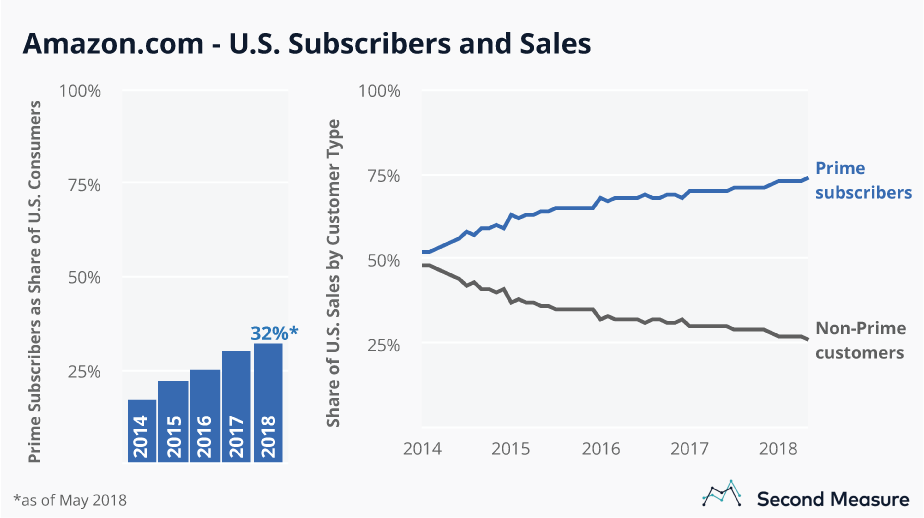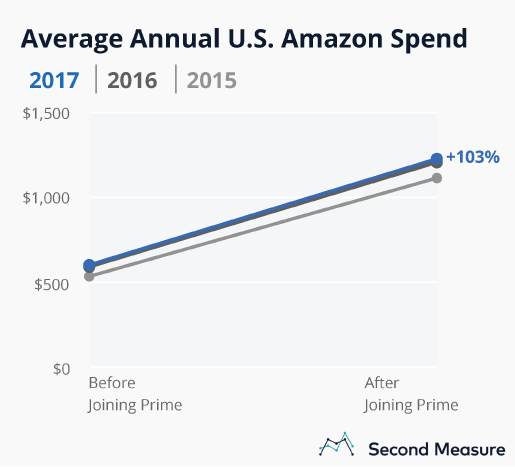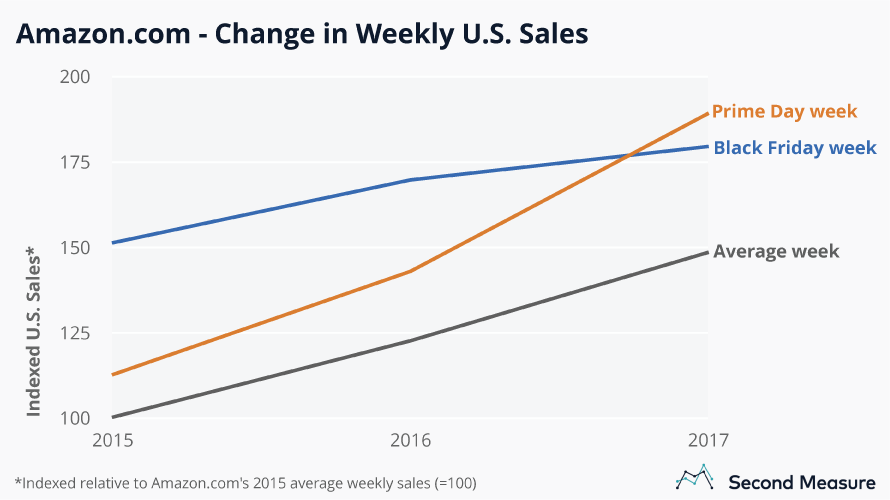NOTE: Bloomberg Second Measure launched a new and exclusive transaction dataset in July 2022. Our data continues to be broadly representative of U.S. consumers. As a result of this panel change, however, we recommend using only the latest posts in assessing metrics, and do not support referring to historical blog posts to infer period-over-period comparisons.
Amazon Prime Day starts today, and the 36-hour shopping frenzy is expected to outshine last year’s 30-hour event, which brought in more sales globally than Black Friday. As much as Amazon might enjoy another record-breaking performance, growing its subscriber base is the real Prime Day victory. Amazon’s business depends on Prime members for nearly three-quarters of the company’s domestic sales, and U.S. memberships are on the rise.
Currently, 32 percent of American consumers are Prime subscribers—more than subscribe to Netflix. What’s more, Prime customers account for an astonishing 74 percent of total Amazon.com sales—up from about 50 percent in 2014.

Because Prime Day deals are only available to subscribers, the July sales event has historically led to an increase in sign-ups. Last year, Prime Day produced Amazon’s biggest spike in global enrollment—ever—though some of these new shoppers potentially could have dropped Prime during the 30-day free trial, thereby skirting membership fees. When those free trials expired, many shoppers did stick around, creating a boost in paid subscribers. Thirty days after Prime Day, Amazon found itself with 85 percent more new U.S. subscribers than on the average day in 2017.
Why Amazon really wants to recruit Prime members
Amazon is eager to increase its subscriber base because new Prime customers pay off in a big way. First-time members who joined between 2015 and 2017 more than doubled their spending at Amazon.com in their first year of Prime, which includes the 30-day trial period. Recent Prime subscribers spent over $1,200 in the year after signing up, on average, compared to roughly $600 spent in the year before having access to Prime.

Prime subscribers also place more orders than non-Prime members. A lot more. In 2017, members averaged nearly one order per week, compared to 16 orders per year for all other customers. It’s yet another reason the company works so hard to bring shoppers into the Prime fold.
This Prime Day, however, new memberships could be stymied by the recent increase in Prime’s annual fee, which the company raised by $20 up to $119 per year. But as Prime’s price has risen, so has its list of perks. Membership includes free two-day shipping as well as access to Prime Video, Prime Music, and Twitch, a platform for streaming video games. Prime subscribers in select regions also enjoy access to Prime Now, Amazon Pantry, and Amazon Fresh—which can include additional fees. Amazon even announced this year’s Prime Day will offer discounts at Whole Foods Market.
Prime is the new black
At many retailers, Black Friday is still the king of sales, but not so at Amazon. In the U.S., Prime Day spending has been increasing faster than Black Friday spending, despite the fact that Amazon’s Black Friday bargains are open to everyone. Last year, Amazon raked in more money the week of Prime Day than it did the week of Black Friday—though neither week topped the rest of the holiday shopping season, from Cyber Monday week up to Christmas.

Since these shopping holidays now sprawl across more than 24 hours, our analysis looks at weekly spending. Prime Day’s dominance over Black Friday is a result of both Prime Day’s growing significance and Black Friday’s decline. Last Prime Day, weekly sales were higher than Black Friday week sales in either 2016 or 2017 and, this year, more Americans than ever are eligible for the exclusive bargains. Meanwhile, Black Friday week’s rate of growth has been slowing, even failing to keep pace with Amazon’s average U.S. sales growth.
It’s a prime day for Walmart and Target online sales, too
While Prime Day serves as a reminder of Amazon’s ecommerce market leadership, competitors need not be glum—Prime Day drives U.S. sales at more than just Amazon. Compared against other weekdays in July, online sales were up across mega-retailers on Prime Day, though in-store sales were down.
Last Prime Day, online sales for Walmart were 53 percent higher than the average Tuesday in July and, at Target.com, that number was 25 percent. The bump may have to do with strategic deal-matching aimed at non-Prime members feeling salty about missing out on exclusive deals. But both Walmart and Target saw in-store sales drop below the July Tuesday average, down 5 and 3 percent, respectively.
Curious whether higher membership fees will lead to lower Prime enrollment this year? Get in touch for more insights.
Oh, and we’re hiring.
